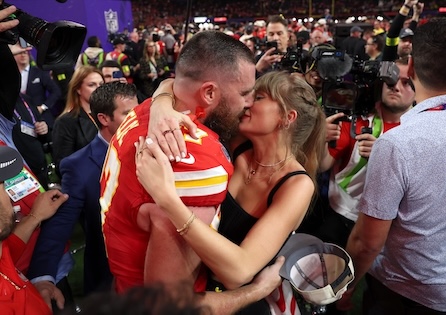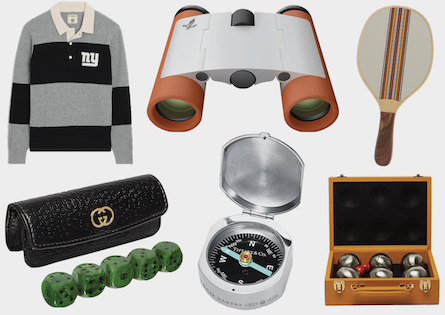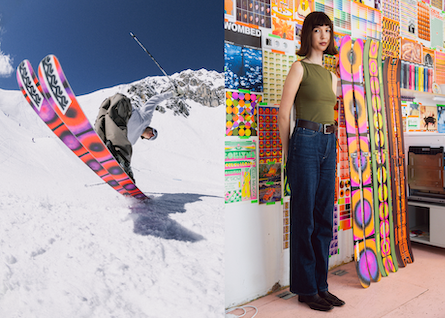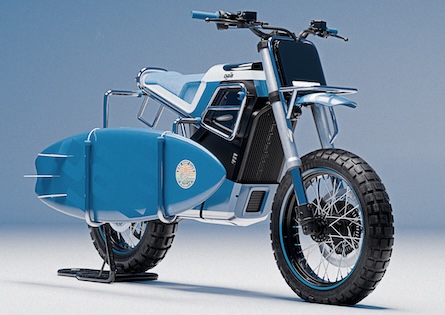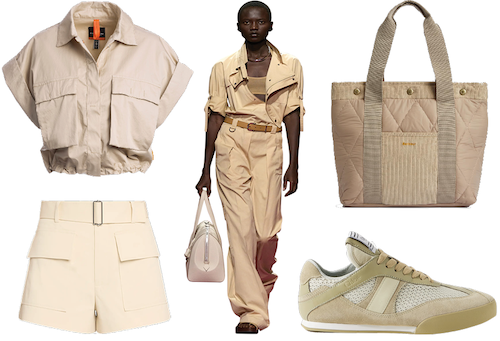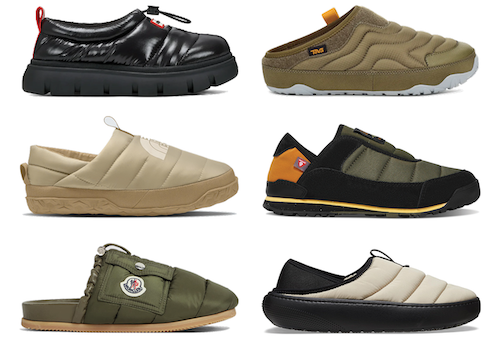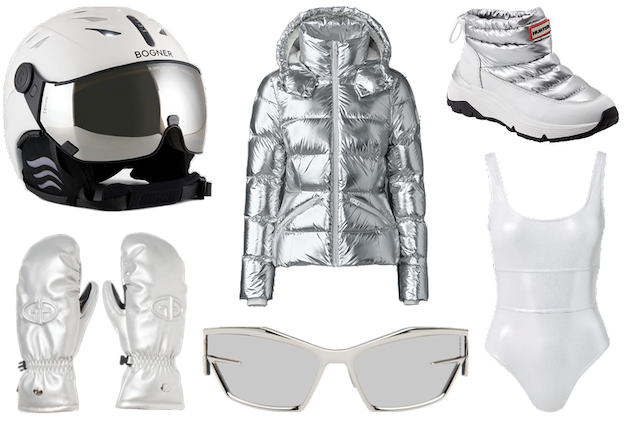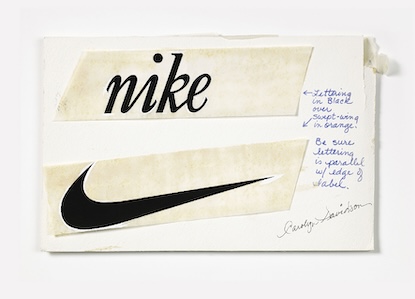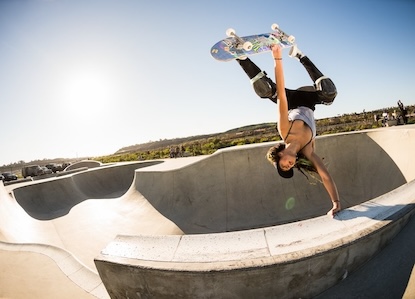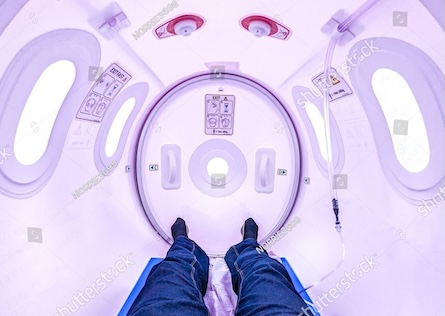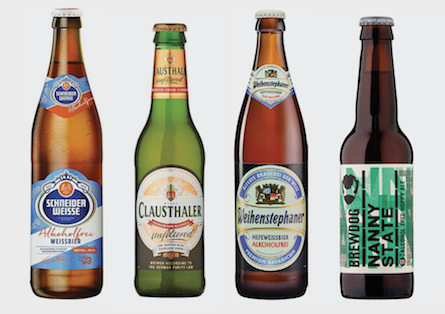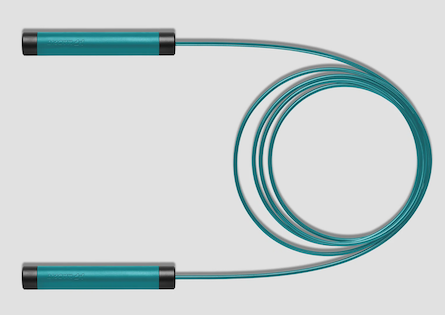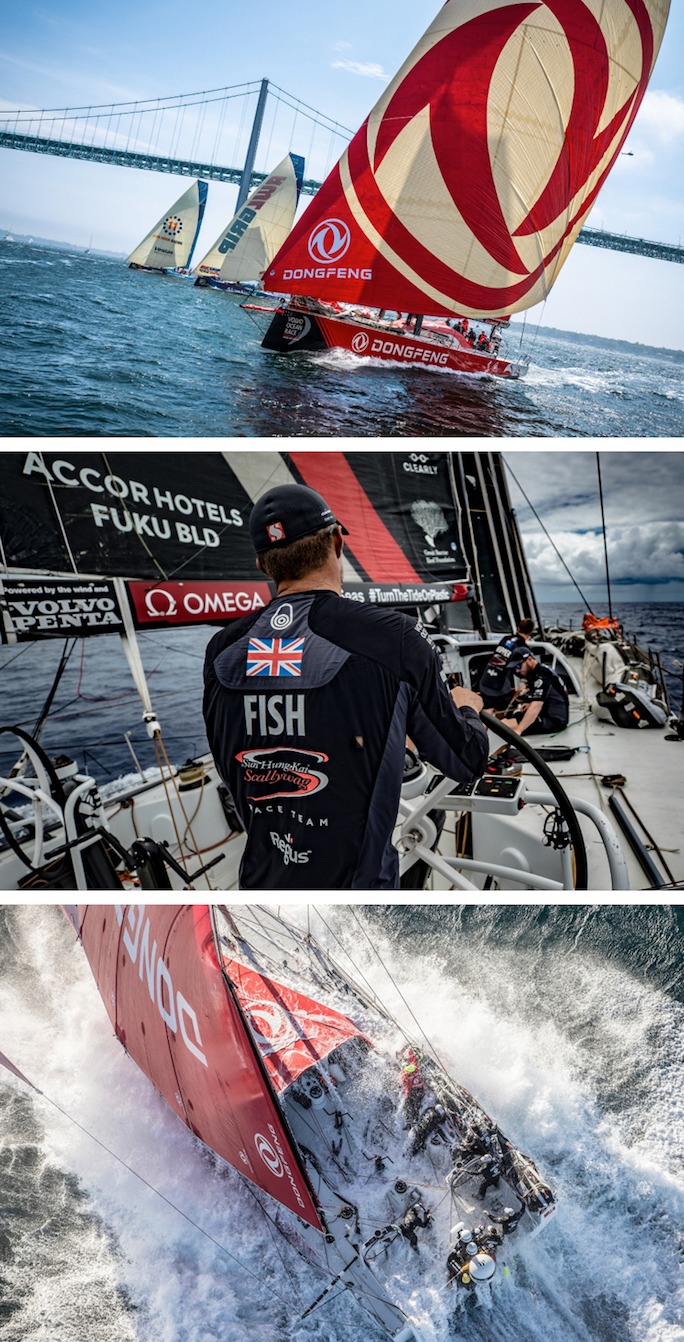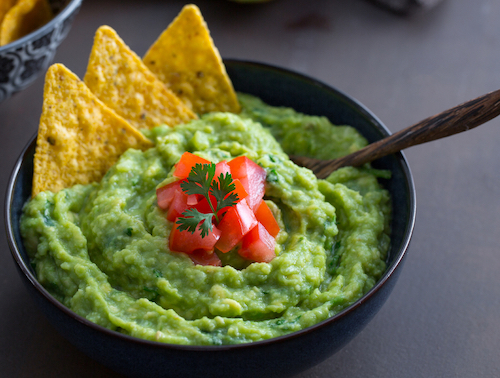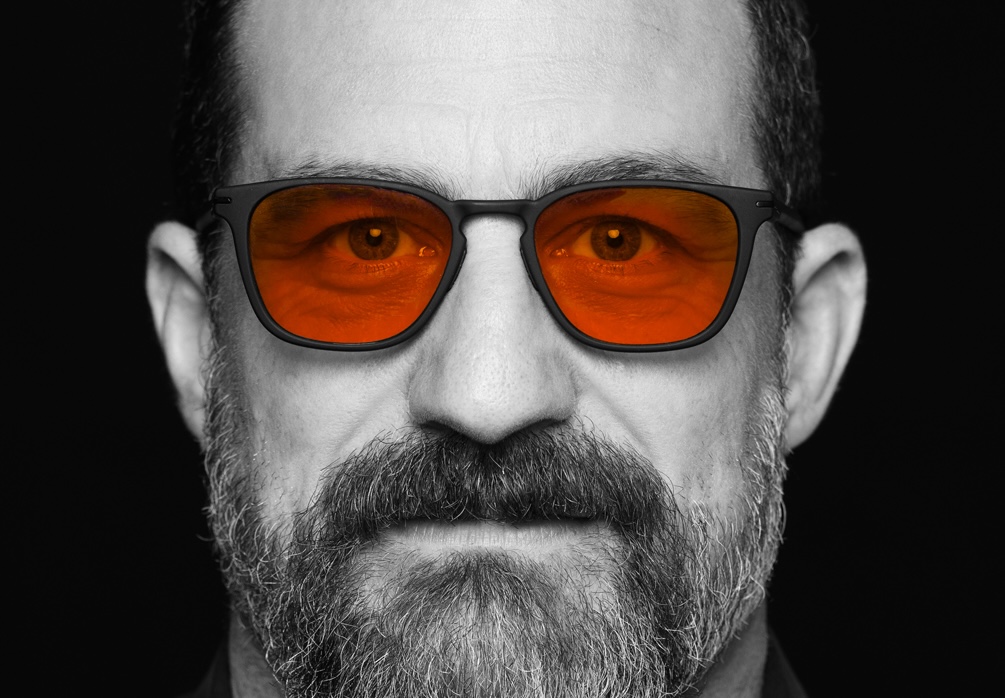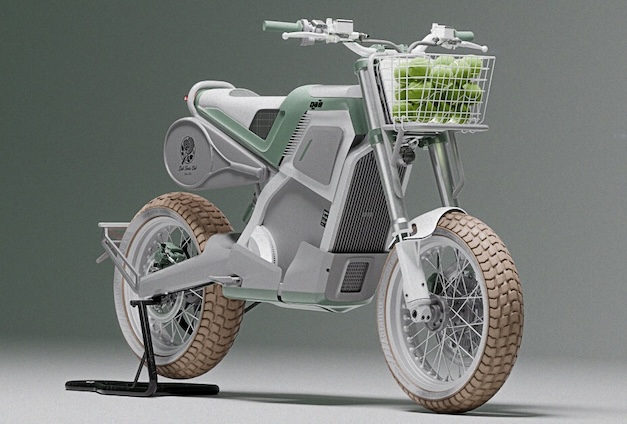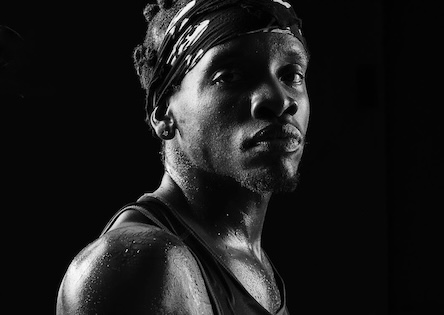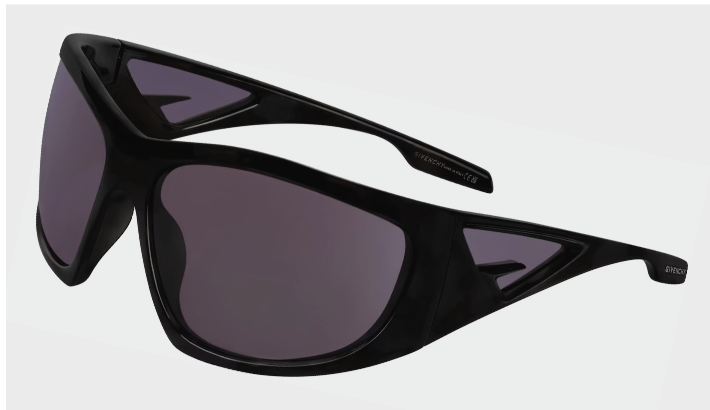From top: Leg 9 start day, Newport to Cardiff, May 20, 2018. Photo by Ugo Fonolla/Volvo Ocean Race; Leg 6, Hong Kong to Auckland, February 18, 2018. Day 12 on board Sun Hung Kai/Scallywag with John Fisher (1970-2018) at the helm. Sadly underlining just how dangerous this race is, Fisher was swept overboard on March 26 in gale force conditions in the Southern Ocean and never recovered. Photo by Jeremie Lecaudey/Volvo Ocean Race; Leg 2 start day, Lisbon to Cape Town, November 5, 2017. Dongfeng Race Team drone shot from above. Photo by Eloi Stichelbaut/Dongfeng Race Team
Crossing the Atlantic Ocean as I write are 7 race boats sailing from Newport, RI to Cardiff, Wales in the 9th leg of the Volvo Ocean Race. With 11 legs in total, ranging from approximately 3 to 22 days at sea, the Volvo Ocean Race is described as the longest and toughest professional sporting event in the world. The race covers 45,000 nautical miles that cross four oceans, touch six continents, and visits 12 landmark Host Cities. What began in October of 2017 in Alicante, Spain will finish in The Hague in the Netherlands at the end of June 2018 in what will have been an 9-month test of endurance in some of the most grueling conditions imaginable.
Since 1973, the Volvo Ocean Race has provided the ultimate test of teamwork and adventure. Originally known as the Whitbread Around The World Race, Volvo took it over in 1998. The race is held every three years, and for more than four decades has held an almost mythical power over some the sport’s greatest. In the current era of One Design racing, every team races the exact same Volvo Ocean 65, ensuring the race is all about the sailing and not about the boat. There is no prize money awarded for the relentless intensity and perseverance required in this round-the-clock pursuit, but for a sailor to see their name etched into one of the silver rings of the Volvo Ocean Race Trophy has a value beyond compare. Put simply, the Volvo Ocean Race is an obsession many of the world’s best sailors have dedicated years of their lives trying to win.
Leg 8, Itajai to Newport, May 6, 2018. Day 15 on board MAPFRE. Photo by Ugo Fonolla/Volvo Ocean Race; Leg 4, Melbourne to Hong Kong, January 13, 2018. Day 12 onboard Turn the Tide on Plastic with Dee Caffari studying the route. Photo by Brian Carlin/Volvo Ocean Race; Leg 6, Hong Kong to Auckland, February 27, 2018. Day 21 sunrise on board MAPFRE passing the Three Kings Islands. Photo by Ugo Fonolla/Volvo Ocean Race
The race course changes each edition with new destinations and host cities. The 2017-2018 edition is highlighted by a few significant features, namely being the longest course in the history of the race. It features almost three times as much Southern Ocean racing as in recent editions — around 12,500 nm — which is known to be particularly arduous and unpredictable. As such, bonus points have been added for victories in those legs, as well as other particularly challenging parts of the course, like being the first to round the notorious Cape Horn.
Most notable in this edition is the number of women in the race. For 2017-2018 incentives were introduced to include more women. All-male teams are limited to seven sailors only, but 1 or 2 additional women can be added to the crew. There is also the option of a 5 men and 5 women crew, or an 11 women all-female crew. This year there is at least one woman on each of the total seven teams, and also a female skipper. Dee Cardiff is at the helm of team Turn The Tide on Plastic along with 4 other women and 5 men.
Leg 6, Hong Kong to Auckland, February 19, 2018. Day 13 on board MAPFRE. Sophie Ciszek fixing a line in the bow. Photo by Ugo Fonolla/Volvo Ocean Race; Leg 6, Hong Kong to Auckland, February 15, 2018. Day 9 on board Brunel. Photo by Yann Riou/Volvo Ocean Race. Leg 2, Lisbon to Cape Town, November 10, 2017. Day 2 on board AkzoNobel. Photo by James Blake/Volvo Ocean Race.
The Volvo Ocean Race is one of sailing’s three coveted victories alongside the Olympics and America’s Cup. On board two of the boats for the 2017-2018 race are two sailors who have won two of those trophies as teammates and are now going head-to-head. New Zealanders, Peter Burling and Blair Tuke won the America’s Cup with the Emirates Team Zealand in 2017 and took home Olympic gold in Rio in 2016. Two of the world’s most successful young sailors – Burling is the youngest winning helmsman in America’s Cup history – each is now positioned to win the Triple Crown of sailing and make history. Victory in all three has never before been accomplished.
So you can imagine my glee when I had the chance to meet these two sailors last weekend as a guest of Omega Watches in Newport, just before their departure for Cardiff. Omega not only sponsors the Volvo Ocean Race as the Official Timekeeper, but just announced Burling and Tuke as the brand’s newest sailing ambassadors. Omega also sponsors Team Emirates New Zealand, the boat on which they won the America’s Cup. To mark the occasion, Omega unveiled the Seamaster Planet Ocean Deep Black “Volvo Ocean Race” which will be presented to each member of the winning team of this year’s race. A Limited Edition of 73 models of the timepiece will be available to the public the day after the race finishes – the number commemorating the year the race began. Forget about owning one, however. The edition is already sold out.
Clockwise top left: Omega Seamaster Planet Ocean Deep Black “Volvo Ocean Race” Limited Edition; Leg 3, Dong Feng arrival in Melbourne from Cape Town, December 24, 2017. Photo by Jesus Renedo/Volvo Ocean Race; Omega sailing ambassadors Blair Tuke and Peter Burling; Leg 8, Itajai to Newport, May 5, 2018. Day 14 on board MAPFRE with Blair Tuke. Photo by Ugo Fonolla/Volvo Ocean Race
The Seamaster Planet Ocean Deep Black “Volvo Ocean Race” is a 45.50 mm divers’ chronograph designed to withstand the extreme pressures of ocean sailing. The casebody is crafted from a single block of unscratchable black ceramic. A brushed black ceramic dial includes each Limited Edition number, as well as 18K white gold hour-minute hands and indexes. Red rubber covers the first 15 minutes of the unidirectional bezel. On the subdial at 3 o’clock, Omega has included a red Volvo Ocean Race ring. Another reference to the event can be found on the caseback, which features the official “Volvo Ocean Race” logo. A black rubber foldover strap, completes the highly durable and functional design of this ruggedly handsome sport watch.
For Omega ambassadors Burling and Tuke now competing against each other, it’s “business as usual.” As Burling told me, “you’re trying to beat them as you would anyone else.” He’s got a little extra motivation courtesy of Tuke, whose Team Mapfre is currently leading the race. However, with double points at stake for this trans-Atlantic leg, anything can happen, and 2 days into Leg 9, Burling’s Team Bruling is currently in the lead. Theirs are not the only boats in the race, and there are still many miles to sail before any of the seven teams contending will claim victory… and see their names etched in that coveted Volvo Ocean Race Trophy.
Follow the boats in real time with the Volvo Ocean Race 3D Tracker App!
Leg 6, Hong Kong to Auckland, February 16, 2018. Day 10 on board MAPFRE at night. Photo by Ugo Fonolla/Volvo Ocean Race; Leg 4, Melbourne to Hong Kong, January 12, 2018. Day 11 onboard Turn the Tide on Plastic. Bleddyn Mon and the endless wait for wind. Photo by Brian Carlin/Volvo Ocean Race; Leg 2, Lisbon to Cape Town, November 8, 2017. Day 4 catching those precious 4 hours in sleep shift on board Dongfeng. Photo by Jeremie Lecaudey/Volvo Ocean Race.
